Apollonia Morril, UC Newsroom

What makes a University of California education so good? There are 266,070 UC undergrads, and perhaps just as many answers to that question. Everyone charts their own course here. But a few features distinguish undergraduate education across all UC campuses: chief among them, hands-on learning.
Undergraduates at all UC campuses roll up their sleeves to learn by doing. In fact, 70 percent participate in research, creative projects, internships or service learning during their time at UC. Experiential learning beyond the classroom lets students go deeper, connecting their education to real work in the field, new discoveries, and the expansion of individual and collective knowledge.
“Doing research has given me real-world experience, but also a real perspective on what I can do with my degree and the steps I need to take in order to get there,” says Klaus Stephenson, an astronomy and astrophysics major in her fourth year at UC Santa Cruz. “The question of what to do after graduation is a lot smaller for me because I've had this experience.”
Hands-on learning takes many forms
Some UC undergrads, like Stephenson, work in campus research labs, collaborating with faculty who are among the world’s foremost experts in their fields. Some develop and lead their own research projects or teach their own courses. In creative disciplines, students generate original works and contribute to faculty projects. Others participate in internships, work with community organizations or join programs to learn hands-on skills that tie into academic and professional fields (scientific scuba diving, anyone?). UC students can study abroad, participate in UC’s program in Washington, D.C. or spend a term conducting environmental research at a UC natural reserve. And that’s just for starters. Whatever form it takes, learning by doing sets students up for success, helping them engage more fully in their studies, make professional connections, gain key job skills, and envision career pathways.
Breakout roles in breakthrough research: STEM fields
Undergraduate researchers are right in the thick of STEM research at UC, helping advance science, engineering and medicine. Kaustubh Simha, a third-year electrical engineering and applied physics double major at UC Irvine, works with a team that is creating a new two-dimensional material that could eventually replace silicon in computers and smartphones, bringing smaller and more powerful computers to our daily lives.

Simha’s experience in the Quantum Materials and Devices Lab under associate professor Luis Jauregui has completely transformed his college experience.
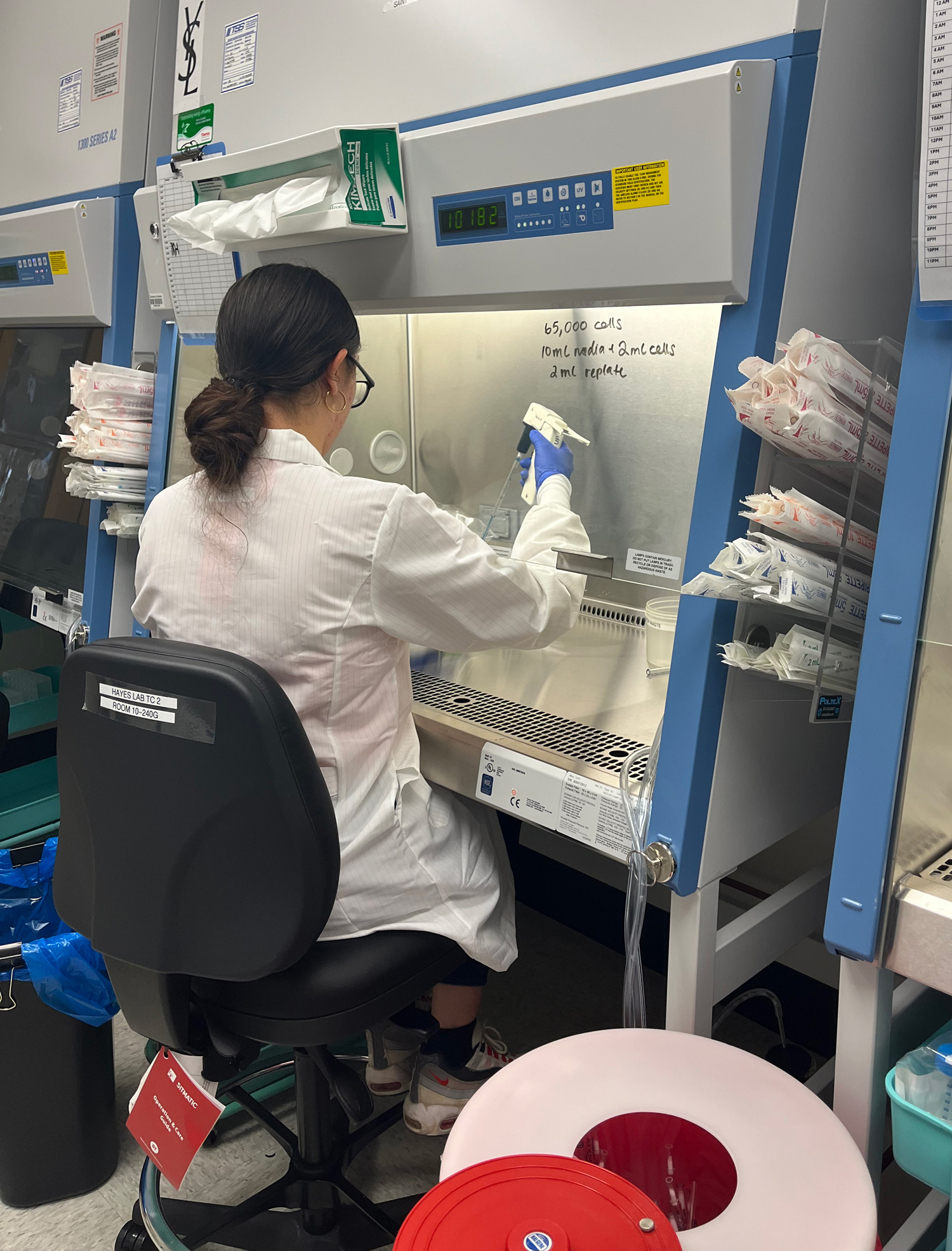
Undergraduate student Kimberly Jorge at work in the Hayes Lab at the UCLA Health Jonsson Comprehensive Cancer Center.
“It has definitely been the defining factor of my time at UC Irvine,” says Simha. “I've met all my mentors and all my people that I really connect with and care for through research. It has shown me that anything is possible. I’d say it’s the reason why you'd want to go to a UC versus any other school. We are an R1 institution. We have some pretty rare equipment, like a fridge that goes down to 0.3 Kelvin. We can do some very cool physics in those systems. I’ve had opportunities here that I don't think I would have anywhere else.”
At UCLA, Kimberly Jorge, a third-year human biology and society major and Chicano studies minor, didn’t know what research was until she got to college. But before school started, she received an email invitation to join PEERS, a two-year research program that includes foundational classes in the first year and a research post in the second year.
At a research “speed dating” event, she connected with her mentor, Dr. Tikvah Hayes, an assistant professor of molecular and medical pharmacology in the School of Medicine and a member of the UCLA Health Jonsson Comprehensive Cancer Center. Now a year and a half into her paid lab work, Jorge is helping Hayes study lung cancer drug resistances and pinpoint the mechanisms of cancer mutations, research that will lead to better treatments and outcomes for patients.
“I’m a pretty reserved person,” says Jorge, “but by joining the lab I've been able to meet so many people. It’s opened up a pathway of looking at all the different careers that are out there. And it feels really good to know that I’m doing something useful with my time, instead of just being in my room or on my phone.”
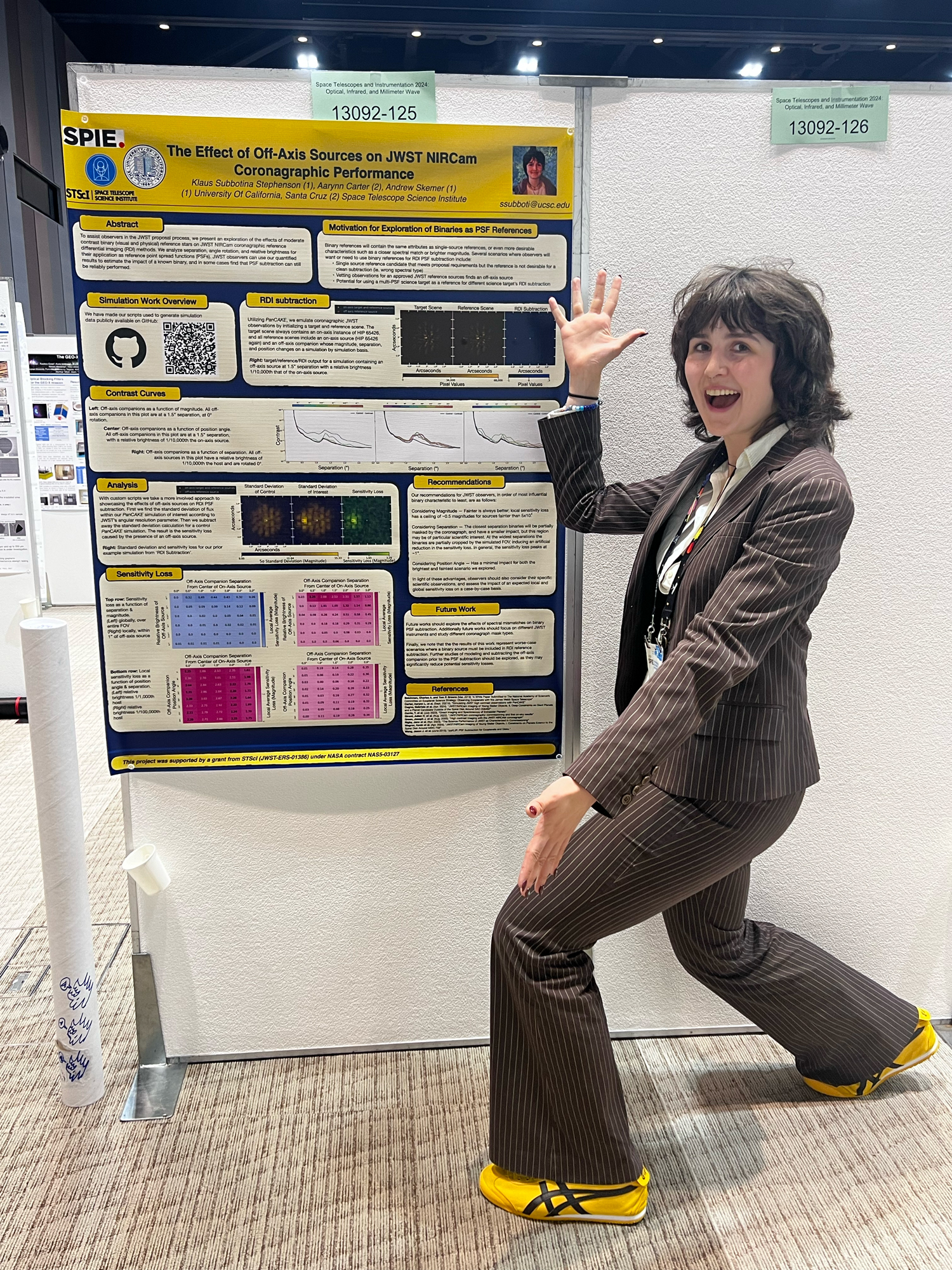
UC Santa Cruz student Klaus Stephenson with a poster from her presentation at SPIE: Astronomical Telescopes + Instrumentation in Yokohama, Japan, June 2024. Her research, which used data from the James Webb Space Telescope, was awarded the UC Santa Cruz 2025 Dean’s and Chancellor’s awards.
Back at UC Santa Cruz, Stephenson has been working with professor Andrew Skemer to find new exoplanets outside of our solar system using data from the James Webb Space Telescope. The work has provided both financial aid for school and class credit. It even landed her a presentation at an international astronomy conference in Tokyo and a summer internship at Lawrence Livermore National Laboratory. After she graduates this spring, Stephenson will start a postbaccalaureate position as an instrument scientist at UC Santa Cruz for the Planet as Exoplanet Analog Spectrograph, a new instrument that is being added onto a telescope at UC’s Lick Observatory, and plans to publish two more first-author scientific papers and present at a conference next year.
“Research really helped me figure out that I want to get a Ph.D. in this field,” she says. “I’ve been able to see what life is really like for academics in a way you don’t get in the classroom. Now I know that I do want the kinds of jobs that require advanced degrees.”
Thinking beyond the beaker: Research in the humanities and social sciences
While a high percentage of STEM students participate in research, social science and humanities students have opportunities, too. Research is essential to creating new knowledge in every discipline at UC; as an R1 institution — a designation reserved for the highest level and most robust university research — it’s foundational across the board. Research opportunities abound in the humanities and social sciences.
Take Allison Wang, a UC Riverside senior whose college resume brims with experiential learning. An honors political science major with a minor in public policy, she got connected with research through a freshman year class with Dr. Kim Yi Dionne. Wang started working in Dionne’s lab for class credit, then stayed on as a paid research assistant, work she has continued throughout her time at UC.
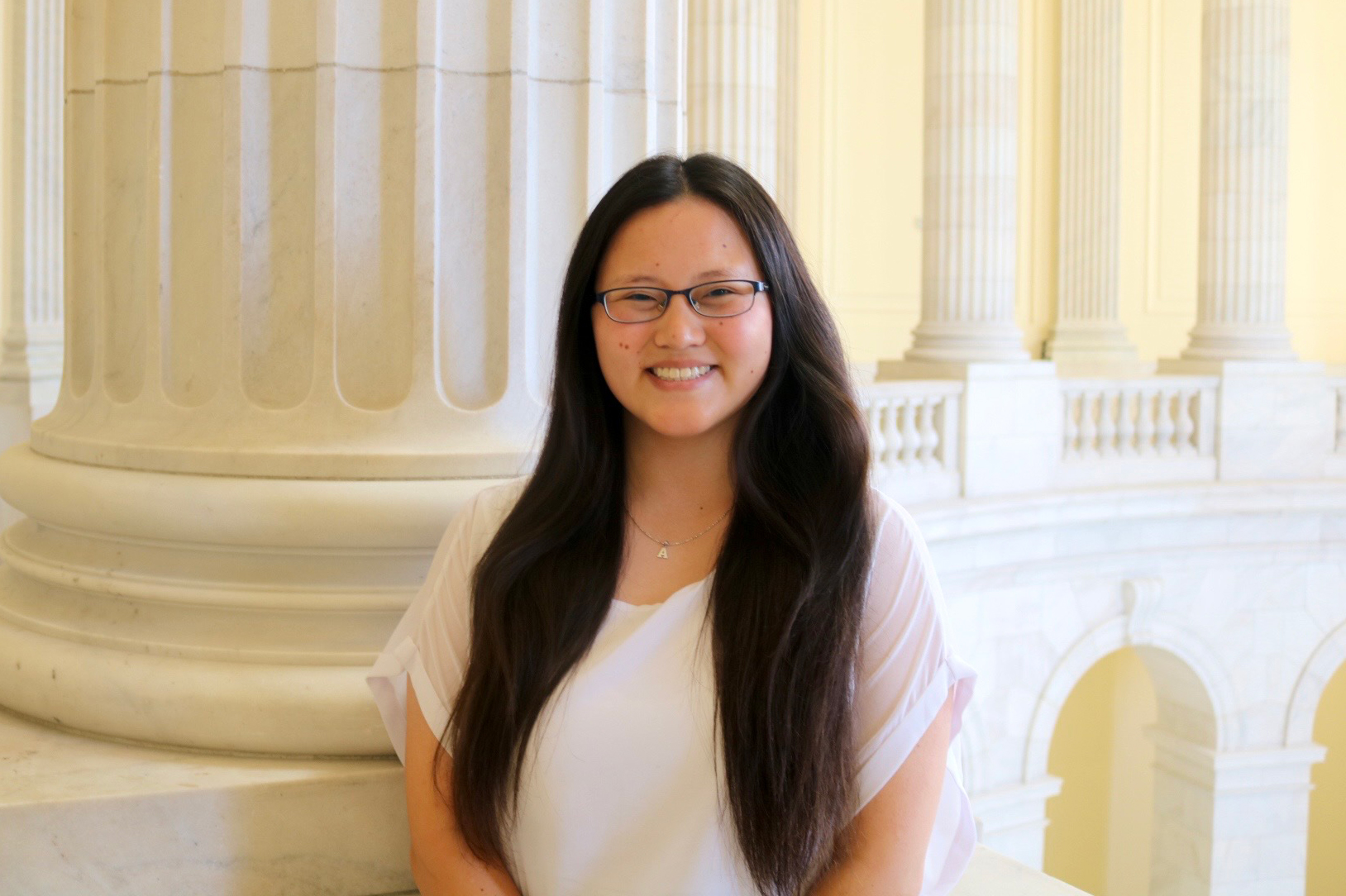
Spurred by her work in the lab, Wang applied for a two-quarter political science research fellowship. Earning both money and course credits, she spent 10 weeks with other students learning about research methods in the humanities and social sciences, including quantitative vs. qualitative research, focus groups, interviews and statistical analysis, and another 10 weeks working with a professor. She was matched with Dr. Joshua Wood, who teaches in the philosophy and political science departments, to research how using AI tools affects students’ academic work.
On top of all this, the Political Science Department Internship Program connected Wang with a local public radio station serving the greater Inland Empire, where she learned how to make shorts on local news. A few months into the work, she realized she could teach these skills to other students. She applied to teach an R’Course, UC Riverside’s program in which students learn about pedagogy for one full term and spend a second term teaching a class of their own design for fellow undergrads. Students in her class, “Local Public Radio Storytelling with 91.9 KVCR News,” are generating a series of stories airing weekly on the station.
Wang has also taken full advantage of engaged learning opportunities to explore her interest in politics. She participated in both the UC Center Sacramento and UC Washington DC (UCDC) summer internship programs, getting a front-row seat to the workings of federal and state government.
“I didn't know anything about government until I did those internships for UC Center Sacramento and UCDC,” says Wang. “I’ve been able to get experience in all three levels of government, federal, state and local, and find out about all the different jobs in politics. It made me want to go into government and specifically helped me zero in on the local level as my biggest area of interest.”
Homing in on that interest, she is finishing out her time at UC Riverside as a Public Service Fellow with the Western Riverside Council of Governments and as an intern with the Lake Elsinore City Manager’s Office. This summer, Wang will be interning with the California State Transportation Agency through UC Riverside’s Ron Loveridge Summer Fellowship, and in the fall she will start her master’s of public administration at USC.

At UC Berkeley, junior Michael Brand works in Dr. Nicole Starosielski’s lab researching the vast network of undersea fiber optic cables that span the globe and enable 99 percent of internet communications. A professor of film and media (which travel through those cables), Starosielski is launching the world’s first undergraduate certificate program in Global Digital Infrastructure at UC Berkeley, which will introduce students to the topic in its technical, economic, legal, environmental and social dimensions. As a member of Starosielksi’s lab, Brand is helping to develop the curriculum. He even co-designed and teaches a class, “Building a Sustainable Internet,” through UC Berkeley’s DeCal program of student-led courses.
Brand, a double-major in environmental economics and policy and legal studies, has worked on Starosielski’s projects and his own research projects. For example, his honors thesis, “Bringing Lightning to the Cloud,” delves into on-site sustainable power sourcing for data centers. With others from the lab, he has even presented his work at major industry conferences in Hawaii, New York and Singapore, and has also given guest lectures at Columbia and USC. Brand, who entered UC with 82 semester units after racking up AP and community college classes in high school, is graduating this spring and going on to graduate school at UC Berkeley’s Goldman School of Public Policy, where he will continue his research with Starosielski.
“Undergraduate research is critical to our team’s efforts to understand and transform digital infrastructure,” says Starosielski. “UC Berkeley undergraduates are producing cutting-edge academic knowledge on the invisible systems that support internet traffic, and ways to enhance their sustainability and resilience.”
Creation as research in art and design
It was junior year when everything started to really click for Donavan Walker, a music composition major in the College of Creative Studies at UC Santa Barbara. The pivot point was a UC study abroad program at the University of Ghana. Walker had been composing his own music back home, but the overseas experience boosted his confidence by helping him realize he could communicate musically even across cultures. “Me Before Ghana and Me After Ghana — it’s like two different people,” he reflects. “It was a way to test my knowledge and everything I had done in my first two years of college and to realize, oh wow, they like my music in Ghana, too. It gave me the validation and confidence to do bigger things.”
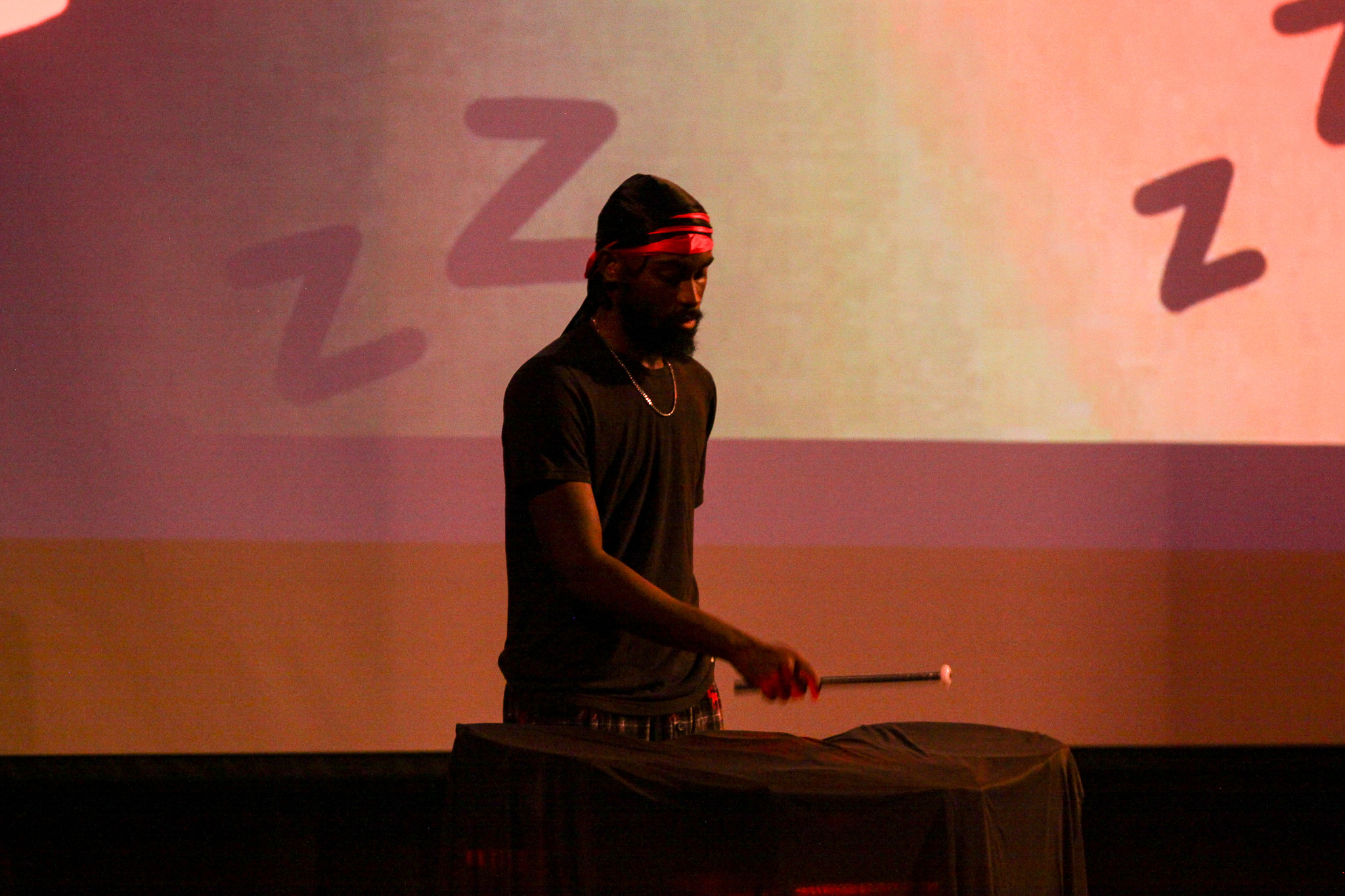
Returning to California, he took on more ambitious projects, flexing his creativity and building interdisciplinary collaborations to produce a campus event featuring an “audio movie” and a short ballet. With school funding, he even took the work to the Texas New Music Festival. This year, Walker’s work culminated in his senior recital — an elaborate, autobiographical multimedia performance incorporating music, dance and video that represents his college journey interwoven with themes of sleep, dreams, and, of course, music. Artistic collaboration has been a theme throughout much of Walker’s work, and, fittingly, he’ll be starting graduate school next year in Music Scoring for Visual Media at Indiana University Bloomington.
“Performance is a way we do research for music,” he says. “It’s testing a theory and putting it out there. I make a piece. Does it sound good? How does the audience react? What parts did they like and why did that work? OK, I’m going to take that and add something to it, or change it, or try something else.”
At UC Davis, landscape architecture student Madi Burns got a chance to see one of her own designs all the way through to the building process. Thanks to the Design and Build Studio class, the department’s courtyard has become a living laboratory brimming with student work, where undergrads can construct their designs and then see how they hold up over time. Every student in the class proposes a project for the space, and one is selected for the group to build. Burns designed a tool shed that doubles as a study space, complete with built-in native wildflower planters, a green roof positioned for visibility from a nearby studio classroom, and a desk positioned for optimum shade so students can use their laptops outside.
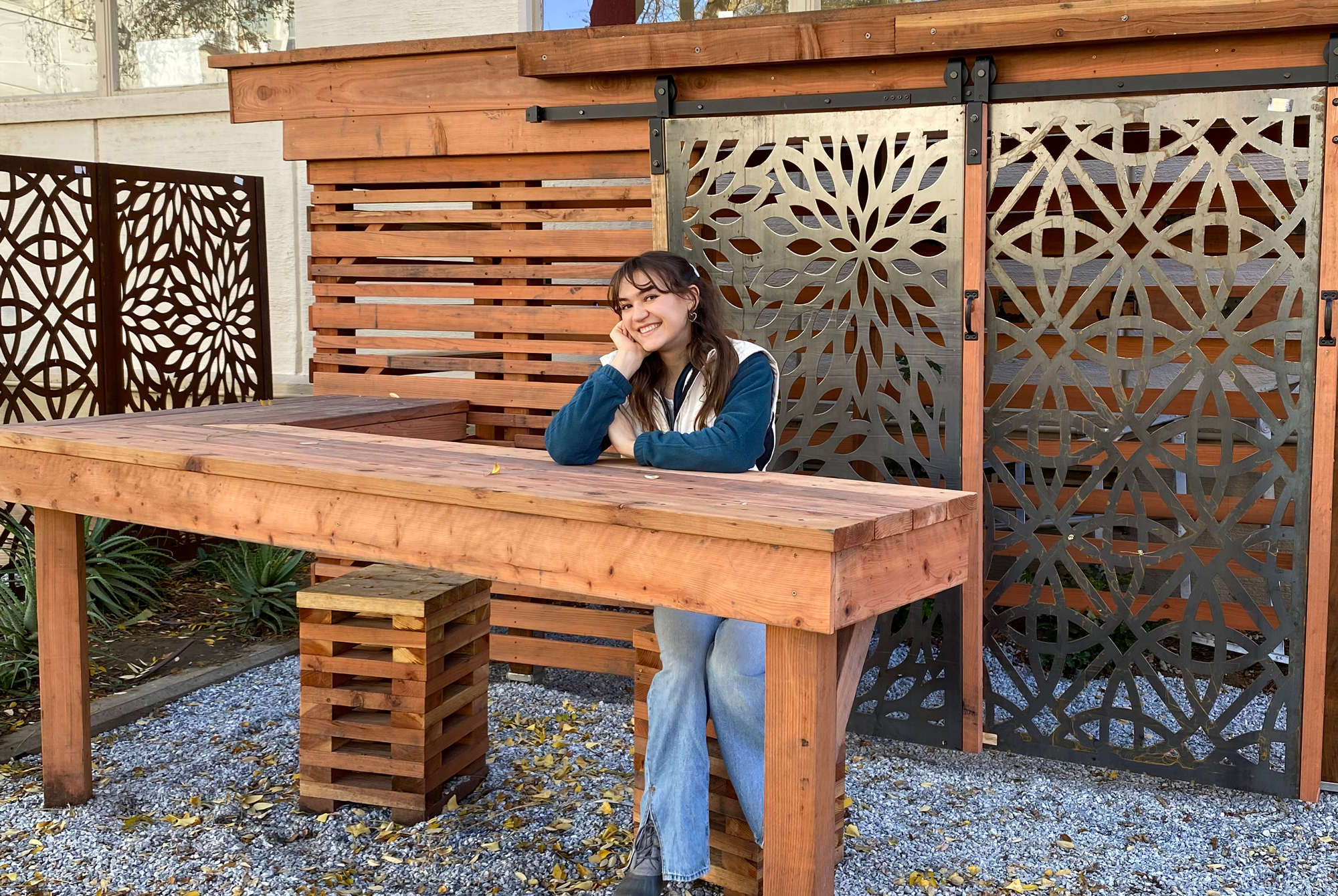
When her design was chosen, she also became the de facto project director. Previously, she had guided a small team of U.S. Forest Service employees collecting data on wildfire resilience in the Santa Rosa tree canopy for the UC Davis Urban Science Lab, leadership experience she was able to draw on for her new role.
“I had to figure out everything from drawing up construction documents to managing a group of 40 classmates,” says Burns. “Learning how to communicate my design vision and seeing how we could all work together to build it and improve on it was really insightful. As a designer, it’s so important to understand how to design things that contractors can actually build.”
The experience helped Burns land a job as a designer in a landscape architecture firm that will start after she graduates this spring. “They saw I was someone who could take a project and run with it,” she says.
How to get involved
There’s no one-size-fits-all applied learning experience at UC, but opportunities abound. It’s possible to find paid or volunteer roles, join campus research programs that offer scholarships and grants, or get class credit for research time. Sometimes the opportunities come through a formal program with an application, while other times students connect with research opportunities through word of mouth or a casual conversation with a graduate student teaching assistant or professor.
Whichever way you slice it, UC undergrads say, start by being proactive. Be willing to try something new, and talk with people who are doing things that interest you. Pay attention to your emails, even before you start school; you’ll get a lot of them, many with research leads. Check out the undergraduate research office on your campus. Take your professor up on that research opportunity they mentioned in class. Just talk with people. You won’t regret it.
“At UC, every single field has experts. No matter what you want to do, you’ll have someone here who’s happy to help and support you to do it,” says Michael Brand.
Kaustubh Simha counsels, “For me it was all about talking to people, saying hi when you pass them on campus, having a conversation, making a connection. One of the best things about UC Irvine is the people. Everybody is so friendly and approachable.”
“I looked up people in my department, knocked on the door of the professor I currently work with and asked if he had any research projects I could help on,” remembers Klaus Stephenson. “Even though I was a random student knocking on his door, he took me seriously and offered me an opportunity, and that has led to so much more.”
At UC Santa Barbara, Donavan Walker sums it up: “If you want to make something happen, there are opportunities and people to help you. And the more you do, the more it builds.”

